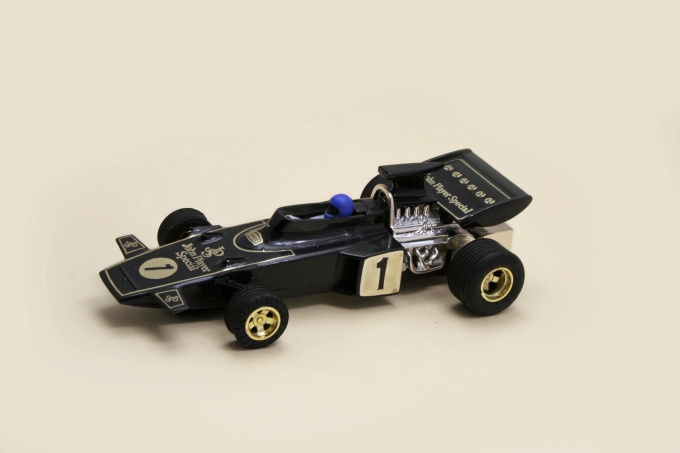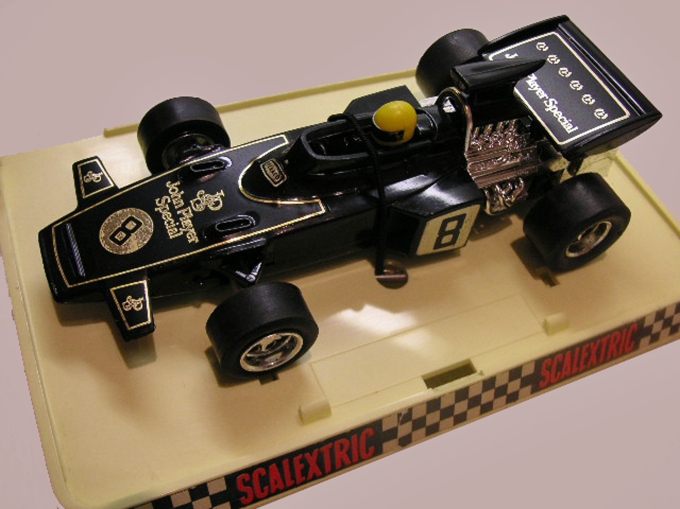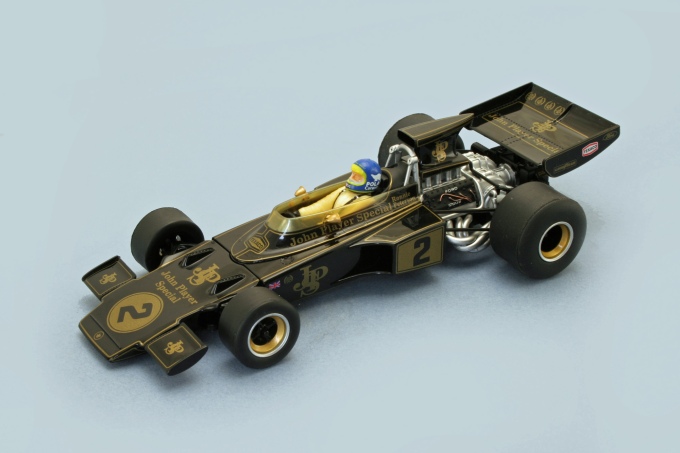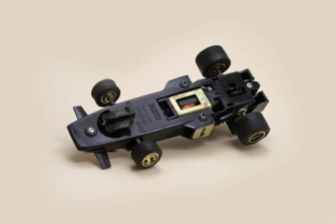C50 Lotus 72 – an exhausting issue.

C50 Lotus 72, No.8 – the original, issued in 1973 with factory applied stickers on body top, side intakes and rear wing.
Hidden in plain sight!
Collectors around the world usually love to know if there is a rare or interesting item out there to be discovered. Once contact with the collecting community is made an understanding of the well-known variations can be understood. Books such as ‘Scalextric Ultimate Guide can also help in gaining the knowledge.

C50 Lotus 72, No.1 issued in 1975. – now with tampo-printed decoration.
However, every now and then something that’s been hidden in plain sight for years appears. Such is the case with the well known C50 Lotus. Unlike the C126 Lotus 77 that has many known variations the C50 Lotus 72 only has two known variations: the No.8 and the No. 1 versions as far as SCALEXTRIC were concerned… perhaps three, if you include the French versions!

The French C50 Lotus 72 – a UK chassis and body, assembled in Calais with French made parts to incude driver helmet, chromed wheel hubs and tyres.
A new era of quality in SCALEXTRIC cars
The C50 Lotus 72 was one of the new models released in the 1970s using the more modern techniques of the era. Scalextric models of the previous decade were, in the main, fairly basic in design and lacking in detail – a typical toy of the 60’s. The 70’s, however, heralded a new thinking in design and the opportunity presented itself when the Scalextric factory was moved to Margate in Kent from Havant in Hampshire. After a settling in period, production of a new range of relatively high detailed models hit the market and were shown in the catalogues as ‘SUPER FORMULA’ cars. Made in the UK, French and Spanish Scalextric factories, the models included the Porsche 917K, March Ford 721, Ferrari 312 B3, Ferrari 330 GT, McLaren M9A, Mercedes Wankel C111, Jaguar E-type, Mercedes 250SL, Tyrrell Ford and, of course, the championship winning Lotus 72. It was stunning in its black and gold JPS livery. The model was a massive hit with Scalextric fans and the model can still be found quite easily half a century later.

One of the accepted variants of the 1975 release – black wheels with gold painted rims.
The known variations
The Lotus 72 was released in 1973 with the race number ‘8’ applied as a decal, as were all the graphics. Silver or gold chromed 5-spoke hubs were fitted. The version assembled in France is easily identified by the French made full face helmet which has a different profile to the UK head. The tyres on the French version are also made in France. These ‘slick’ tyres have an unrealistic square edge profile.
The chassis was amended for the 1975 release so that the Johnson motor would be fitted. At the same time the front of the chassis was amended to allow the motor wires to move more freely as the guide blade rotated.
In 1975, the model was again released as C50 but now with race number ‘1’ reflecting its Championship winning status and, furthermore, the number and all other graphics were now tampo-printed on to the car. The RX motor is replaced by the Johnson motor. The chassis was also updated at some point to allow the wires from the guide blade to the motor to move more freely.
After an exhausting search…
Not obvious to the eye, until pointed out, is a huge assembly error that besets both French and UK models. During assembly of the exhaust components a significant amount were fitted to the engine casing in the wrong orientation resulting in the exhaust pipes pointing forward to the side pods next to the driver!

C50 Lotus 72 with exhaust pipes feeding in to the cooling pods next to the driver!
It went viral!
Not only was it a general production error, it was also released as an official spare part. The officially bagged part, labelled as “Part No 06014PLTD ENGINE/EXHAUST” can be found incorrectly assembled with the exhausts pointing in the wrong direction. The moulding, as a whole, is in three separate pieces, with the exhaust headers “swaged” or heat-staked into place from the inside of the engine body. Of course, the exhaust pipes should point backwards.
Images, inside and out, showing how easy it was for factory staff to assemble the exhausts pipes incorrectly.
The moulding was made in England, assembled and fitted to the Lotus 72, sold in the UK as a Engine/Exhaust part and also exported to the factory in Calais as a component, along with the chassis and body parts for the C50 Lotus 72, that was also being assembled and sold there for the European market. The French version of the C50 model was assembled with the addition of the French driver’s head, fully chromed wheels hubs and slick tyres. The French versions would however, still state “Made in Great Britain” on the UK produced underpan. This was quite normal for models of this period where they were shared in the UK and French production ranges, and sending parts abroad for assembly was often a means of avoiding import duties.
And there it is! Like a virus it was installed in to the distribution chain in plain sight but was unseen until it was too late. Whether anyone in the SCALEXTRIC workforce knew about this or not is unknown though I suspect enthusiasts may have raised this with SCALEXTRIC. It would have been far too late to do anything about it.
Mistakes can certainly be manifold!
With all the help and knowledge available it does make you wonder how a basic mistake can be so easily made – and go undetected through the entire production process right through to market. It should be remembered that the factory operatives would not know how a modern F1 engine would work or what it would like. Fitting the exhaust headers 180 degrees out of true was an easy mistake to make. The QC Department and the foreman in charge of the build process is where any blame might lay. If it wasn’t for the convenient fit of inverted manifolds to look like they were designed that way then the error would probably have been realised by the operatives.

More QC problems? Engine and exhaust unit not chromed but more likely an engineering sample.
Four decades later,…
Scalextric released the Lotus 72 again but, this time, with new tooling. So far, no variations that we know of!

Who would have thought then, a different production version of the C50 Lotus 72 has been under our noses for so long?
But Hey! This, and the hundreds of other production errors since 1957 to date, is what makes out hobby so interesting!
Reference: Scalextric Ultimate Guide, 8th Edition,
If you believe you have a yet unrecorded variant and seek confirmation of its authenticity, please contact me at slotcarportal.com.
“Scalextric – The Ultimate Guide 8th Edition” book, with over 700 pages, is available from the Internet. Search online!







The chassis was updated for the Johnson 111 motor ahead of the 1975 release. The no.8 car I still have from my birthday in December 1974 is fitted with the Johnson motor not the RX motor so another variant could be that there will be no.8 cars with the RX motor and no.8 cars with the 111 motor.
LikeLike
C50, No8, Johnson motor now added to the Edition 9 book. If you have a good picture of the top and underneath f the car please send them in. Thank you. 🙂
LikeLike